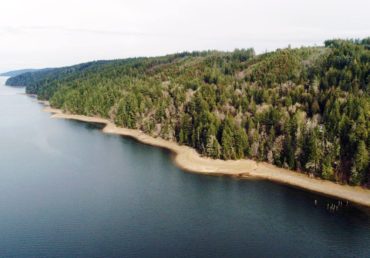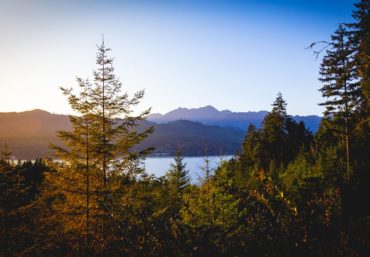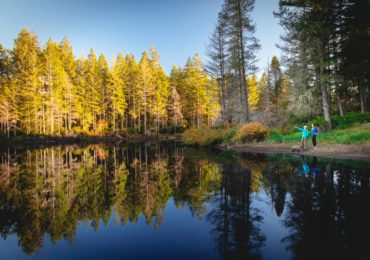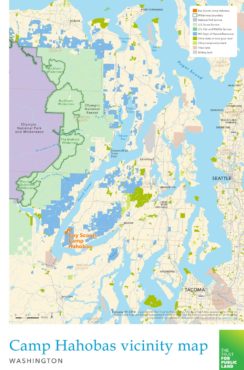
A recently formed public-private partnership will protect Camp Hahobas on the shores of Hood Canal near Belfair. Working in collaboration, The Trust for Public Land, Great Peninsula Conservancy, Washington State Department of Natural Resources and U.S. Navy have protected important lands in the unique Hood Canal ecosystem for multiple public benefits, including habitat conservation, recreation, forest management and military readiness for the Navy.
“This collaboration is about creating shared success for the community and our state. By working in partnership, we are preserving working forestland, supporting the local economy and protecting critical wildlife and fish habitat,” said Commissioner of Public Lands Hilary Franz.”

While the Pacific Harbors Council of Boy Scouts will retain ownership of 120 acres of former Boy Scout Camp Hahobas, the remaining 430 acres will be divided into two ownerships in order to best conserve the property and its various natural resources.
A loan from The Conservation Fund, a national land protection partner, to Great Peninsula Conservancy was also used to acquire the property. The Navy was a significant funding partner in this transaction, with the purchase of a restrictive easement over the entire 430-acre property that prevents incompatible development and protects recreational and natural resource uses.

The Navy is contributing the funding from the Readiness and Environmental Protection Integration (REPI) Program. By protecting the lands surrounding Hood Canal, the Navy can ensure that vital training and testing for submarines at Naval Base Kitsap can continue well into the future. As a nationwide program, REPI enables the Navy and the other military services to simultaneously prevent incompatible development near installations, protect natural resources and promote military readiness.
“The Navy has created a strong partnership with our Readiness and Environmental Protection Integration partners in Hood Canal,” said Capt. Alan Schrader, Naval Base Kitsap commanding officer. “Together we’ve protected more than 12,000 acres of habitat and working forests in Hood Canal. This project represents an opportunity to bring together multiple land trusts and agencies to reach a common goal. In addition, it protects the Navy’s mission from incompatible development, while providing public recreation opportunities and habitat protection.”
“This project represents a remarkable team effort by all parties to protect this unique, incredible property and to keep it open to the public. Visitors are able to stand on the shoreline and look west across Hood Canal and see the peaks in the heart of Olympic National Park,” says Richard Corff, Trust for Public Land Washington director of land conservation. “I can’t wait to show my kids and it seems incredible, in our quickly changing world, that they will be able to show their kids the same place when the time comes.”

Since the 1930s, generations of children have spent their summers at Camp Hahobas on Hood Canal’s scenic shores. Recently, the Pacific Harbors Council decided to consolidate its operations into one camp. Fortunately, when the Scouts made the decision to sell a large portion of Camp Hahobas, the organization approached The Trust for Public Land with a desire to keep this scenic location open to the public and prevent summer home development.
“The Outdoor Code reads: As an American, I will do my best to — be clean in my outdoor manners. Be careful with fire. Be considerate in the outdoors. Be conservation minded. Every Scout learns the Outdoor Code as a part of our training. Being involved with the Trust for Public Land and being able to conserve this land for future generations felt like good Scouting,” said Pacific Harbors Council Scout Executive, Ralph Voelker.
Most of the upland portion of the property, about 268 acres, will be owned by Washington State Department of Natural Resources, and managed as working forest to support local public schools and public access to the outdoors. The more sensitive Hood Canal shoreline will transfer to Great Peninsula Conservancy to protect habitat for fish and wildlife and provide opportunities for public enjoyment of nature. This portion of the property is made up of nearly 162 acres of evergreen forest and more than half mile of shoreline and tidelands.
“This remote shoreline on Hood Canal is a place of incredible beauty and significance to fish and wildlife. Walking the beach feels like a step back in time. Great Peninsula Conservancy members are proud to conserve this natural legacy for our children and grandchildren,” said Sandra Staples-Bortner, executive director of Great Peninsula Conservancy.























Comments